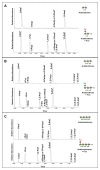At FUT4 and At FUT6 Are Arabinofuranose-Specific Fucosyltransferases
- PMID: 33633757
- PMCID: PMC7900004
- DOI: 10.3389/fpls.2021.589518
At FUT4 and At FUT6 Are Arabinofuranose-Specific Fucosyltransferases
Abstract
The bulk of plant biomass is comprised of plant cell walls, which are complex polymeric networks, composed of diverse polysaccharides, proteins, polyphenolics, and hydroxyproline-rich glycoproteins (HRGPs). Glycosyltransferases (GTs) work together to synthesize the saccharide components of the plant cell wall. The Arabidopsis thaliana fucosyltransferases (FUTs), AtFUT4, and AtFUT6, are members of the plant-specific GT family 37 (GT37). AtFUT4 and AtFUT6 transfer fucose (Fuc) onto arabinose (Ara) residues of arabinogalactan (AG) proteins (AGPs) and have been postulated to be non-redundant AGP-specific FUTs. AtFUT4 and AtFUT6 were recombinantly expressed in mammalian HEK293 cells and purified for biochemical analysis. We report an updated understanding on the specificities of AtFUT4 and AtFUT6 that are involved in the synthesis of wall localized AGPs. Our findings suggest that they are selective enzymes that can utilize various arabinogalactan (AG)-like and non-AG-like oligosaccharide acceptors, and only require a free, terminal arabinofuranose. We also report with GUS promoter-reporter gene studies that AtFUT4 and AtFUT6 gene expression is sub-localized in different parts of developing A. thaliana roots.
Keywords: AtFUT1; AtFUT4; AtFUT6; Fucosyltransferase; GT37; arabinogalactan protein; hydroxyproline-rich glycoprotein; plant cell wall.
Copyright © 2021 Soto, Prabhakar, Wang, Backe, Chapla, Bartetzko, Black, Azadi, Peña, Pfrengle, Moremen, Urbanowicz and Hahn.
Conflict of interest statement
The authors declare that the research was conducted in the absence of any commercial or financial relationships that could be construed as a potential conflict of interest.
Figures









Similar articles
-
Functional identification of two nonredundant Arabidopsis alpha(1,2)fucosyltransferases specific to arabinogalactan proteins.J Biol Chem. 2010 Apr 30;285(18):13638-45. doi: 10.1074/jbc.M110.102715. Epub 2010 Mar 1. J Biol Chem. 2010. PMID: 20194500 Free PMC article.
-
Biochemical and physiological characterization of fut4 and fut6 mutants defective in arabinogalactan-protein fucosylation in Arabidopsis.J Exp Bot. 2013 Dec;64(18):5537-51. doi: 10.1093/jxb/ert321. Epub 2013 Oct 14. J Exp Bot. 2013. PMID: 24127514 Free PMC article.
-
Characterisation of FUT4 and FUT6 α-(1 → 2)-fucosyltransferases reveals that absence of root arabinogalactan fucosylation increases Arabidopsis root growth salt sensitivity.PLoS One. 2014 Mar 25;9(3):e93291. doi: 10.1371/journal.pone.0093291. eCollection 2014. PLoS One. 2014. PMID: 24667545 Free PMC article.
-
Extensin and Arabinogalactan-Protein Biosynthesis: Glycosyltransferases, Research Challenges, and Biosensors.Front Plant Sci. 2016 Jun 15;7:814. doi: 10.3389/fpls.2016.00814. eCollection 2016. Front Plant Sci. 2016. PMID: 27379116 Free PMC article. Review.
-
Three Decades of Advances in Arabinogalactan-Protein Biosynthesis.Front Plant Sci. 2020 Dec 15;11:610377. doi: 10.3389/fpls.2020.610377. eCollection 2020. Front Plant Sci. 2020. PMID: 33384708 Free PMC article. Review.
Cited by
-
Putative rhamnogalacturonan-II glycosyltransferase identified through callus gene editing which bypasses embryo lethality.Plant Physiol. 2024 Jul 31;195(4):2551-2565. doi: 10.1093/plphys/kiae259. Plant Physiol. 2024. PMID: 38739546 Free PMC article.
-
Phenotyping, genome-wide dissection, and prediction of maize root architecture for temperate adaptability.Imeta. 2025 Mar 13;4(2):e70015. doi: 10.1002/imt2.70015. eCollection 2025 Apr. Imeta. 2025. PMID: 40236777 Free PMC article.
-
Polymerization of the backbone of the pectic polysaccharide rhamnogalacturonan I.Nat Plants. 2022 Nov;8(11):1289-1303. doi: 10.1038/s41477-022-01270-3. Epub 2022 Nov 10. Nat Plants. 2022. PMID: 36357524 Free PMC article.
-
Biochemical and Functional Characterization of GALT8, an Arabidopsis GT31 β-(1,3)-Galactosyltransferase That Influences Seedling Development.Front Plant Sci. 2021 May 25;12:678564. doi: 10.3389/fpls.2021.678564. eCollection 2021. Front Plant Sci. 2021. PMID: 34113372 Free PMC article.
-
Genetic basis of resistance to southern corn leaf blight in the maize multi-parent population and diversity panel.Plant Biotechnol J. 2023 Mar;21(3):506-520. doi: 10.1111/pbi.13967. Epub 2023 Jan 9. Plant Biotechnol J. 2023. PMID: 36383026 Free PMC article.
References
-
- Bonin C. P., Potter I., Vanzin G. F., Reiter W. D. (1997). The MUR1 gene of Arabidopsis thaliana encodes an isoform of GDP-d-mannose-4,6-dehydratase, catalyzing the first step in the de novo synthesis of GDP-l-fucose. Proc. Natl. Acad. Sci. U. S. A. 94, 2085–2090. 10.1073/PNAS.94.5.2085, PMID: - DOI - PMC - PubMed
Grants and funding
LinkOut - more resources
Full Text Sources
Other Literature Sources
Molecular Biology Databases
Miscellaneous

